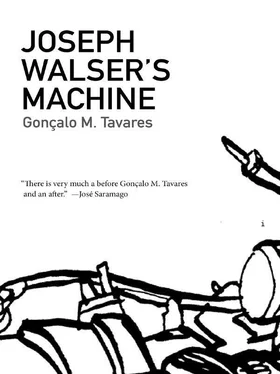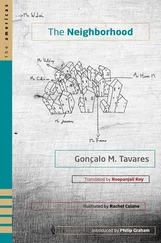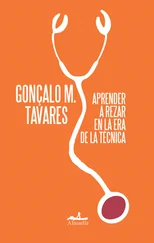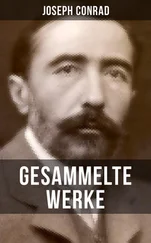For Walser, it had become clear that one’s existence was made up of a succession of behaviors directed at objects and at other men, and that these behaviors, these ways of acting — crude as they might be — were, objectively speaking, nothing more than a series of clearly delineated movements taken by one’s musculature, easily located on an anatomic chart. The biography of a Man was, at root, merely the movements that his muscles had made.
Each individual event could thus be, not reduced, but likened to — the question was one of equivalence, identity, not of reduction or a loss — the sum total of one’s gestures, the way that a machine — as complex as it might be, as marvelous as its actions might be — is nevertheless nothing more than the sum total of its parts, which, under certain circumstances, perform actions. Walser didn’t think it right for Man — purely by virtue of being able to reflect upon the mechanisms of his existence — to pride himself on being so very different from machines. Merely being able to distance oneself from one’s constituent mechanisms doesn’t mean that those mechanisms cease to exist. Thus, a human existence was, for Walser, a simple sum. The mathematical plus sign reigned in all living beings, and death was so dreadfully frightening precisely because it represented an abrupt interruption of the arithmetic that, at some level, everyone was made to think would go on forever. As if each person, at a given moment, conceived of his body in these terms: as an immortal summation of various behaviors . No one in this century, even after so many successive generations had come and gone — even in the middle of a war, when death is more visible than ever — had ever failed to be surprised (Walser was certain of this) by their own death. We’re always surprised! As if we believed we had the right, after so many days of continued existence, to never be interrupted; as if we had the basic right to belong to a completely different species, to a legitimately never-ending species. This is more than just a belief in an individual eternity in the abstract; this is a belief in an eternity with our own name on it, an eternity that attaches itself to our singular existence.
And then Walser couldn’t help but get caught up in a sense of pride: he, yes he, was a Great Man after all, a Man, as Klober contended, who had been able to separate himself from everyone else, a Man who was truly alone and individual. Precisely because his actions didn’t seem to have any connection to other people — as if those other people didn’t exist. They were absolutely separate, he and other people; his actions were independent, autonomous, and that was his greatness. In short, there was, in Walser, at last, a generalized hatred, a hatred that was serene yet universal, a hatred directed at each and every individual that crossed paths with his existence.
And yet, he would never be an emperor; History would never, regarding Walser, tell of the way he had exterminated this or that number of his fellow human beings, because he, Walser, would never get close to anyone. He was not yet the true Man, as Klober had put it, the Man who only ventures near other people in order to kill them; but, nevertheless, there was still something very significant in Walser: his every point of proximity to other existences, even if these weren’t approached with the intention of killing the other person, were, by nature, and had been for some time, taken up with the intention of not loving the other person. I can draw near to anyone with perfect security, thought Walser, remembering the kiss he’d given Clairie, I can draw near to anyone without fear because I know I won’t love them. I am prepared to not love anyone —and this sentence, thought in this way, felt like a powerful weapon — in wartime — a powerful defense against the hostility of the century. Walser didn’t even own a pistol, but he had eliminated the great weakness of existence, he had made the principal fragility of the species disappear: he had no inclination toward love or friendship! And in that moment, while walking down the street, unarmed, looking down at his old, brown shoes, his irresponsible shoes, as Klober used to say mockingly, at that moment Walser felt as safe — and at the same time as threatening to others — as if he were proceeding down the street in a tank.
However, he suddenly jumped to the side. He had almost stepped on a large, amorphous mass. It was a man. And he was dead.
Someone had purposefully placed the man there. Sometimes soldiers would leave the bodies of guerrillas or conspirators out in the middle of the road — for some time, even days on end — for the whole population to see.
The corpse was lying face down and the blood on the asphalt beside its head was already dry. He had been killed there, at this exact spot.
No uniform: he was wearing black pants, a black belt, and a gray shirt. Walser bent over slightly to see his face. Maybe it was someone he knew. He bent over some more: nope, no one he knew. It was a man. Just a man, he murmured.
The man didn’t have any shoes on. Certainly someone had stolen them from him. The world goes on, and this detail, the absurd absence of the man’s shoes, proved it. Someone had stolen from the corpse.
And now Walser felt pride for his city. It goes on, it endures, it survives. It’s intelligent, this city, he thought.
He wasn’t ashamed; Walser hadn’t felt that kind of propriety for some time. There was a corpse on the street that no longer needed shoes: someone had stolen them; all was well. It would be irrational to leave shoes there, on a dead man’s feet. An intelligent city, he thought again.
Meanwhile, some people passed by; one of them walked over and looked at the corpse. “Another one,” the man said; Walser nodded in agreement and the man walked away. Another person came close by but didn’t slow down; he said nothing and maintained his pace.
Joseph Walser kept looking. He looked at the corpse’s hands. First at the left hand, then at the right hand. The dead man’s palms were facing up.
Instinctively, Walser counted the fingers on each hand. Five fingers. Two perfect, complete hands. More than that: they were clean: without a single spot of blood or dirt on them. Clean and normal. The hands of a living man, you could say.
He kept looking at the dead man’s perfectly intact fingers. He smiled, and had the urge to say out loud, to anyone who was a part of that silent spectacle: How can a man be dead if his hands are still intact? How can he be dead if he has five fingers on each hand?
He laughed to himself at the absurdity of it. An obscene affront to existence and events: the corpse had two perfect hands!
Another thought passed through Walser’s head: just as the thief had stolen the dead man’s shoes, Walser could snatch the dead man’s right hand, take it with him, and switch it with his own. What would the dead man want with all those fingers, since he’s already dead?
Walser looked around him, as if to see if anyone was watching, and, for a second, felt like his plan was viable: he would steal the dead man’s right hand and run off.
But no, it wasn’t possible; in that situation, jealousy was a waste of emotion. The man was dead; Walser was not in fact confronted with this man, even though he was only a few inches away. “He’s gone,” said Walser.
A very sensible word to use when speaking of a dead person: gone , gone away from here. The man had taken a trip. But how is it that someone so passive could travel? Travel after death —Walser tried to smile.
But then a minor detail caught his attention: the belt. The corpse’s back was facing him, so only the back of the belt was visible, but it would certainly have a buckle.
Читать дальше












